Can You Upload Ev3 Programs From The Brick Onto An Ipad
New MINDSTORMS® EV3 programming software is finally here and is set up to shine!
EV3 Classroom was released gradually, starting time for MacOS in November 2019, then for Windows ten, Android and Chromebook a year afterward in 2020.
Now that information technology's available for everyone, we decided to examination information technology out.
We are pleased to announce that nosotros have launched a make-new EV3 app called 'LEGO® MINDSTORMS® Teaching EV3 Classroom'. Featuring a coding linguistic communication based on Scratch and like to the LEGO® Education Spike™ app, EV3 Classroom will replace the current EV3 Lab and EV3 Programming app products. This is in order to provide a consistent feel, features and content across all of the currently supported computer and tablet devices.
– Notice at LEGO® MINDSTORMS® Education EV3 Instructor Edition
This informative notification already tells us several interesting things near what to expect from the new programming app and from LEGO® itself, every bit far as the strategy for educational products yet to come is concerned. One could speculate there's as well a veiled threat that EV3 Classroom will inevitably become the simply programming app for MINDSTORMS® EV3. For now at least, that has not become true.
Before drawing any further conclusions, let'south clarify the real differences between EV3 Lab and EV3 Classroom. We will also try to answer the most important question - is the new app better for programming robots?
Just in case you are now wondering what EV3 Lab is and why you accept never heard of information technology earlier, let's clarify. EV3 Lab is the previous, renamed programming software for this kit, until recently known equally LEGO® MINDSTORMS® Educational activity EV3 Teacher Edition. Except the name has been changed.
If you are looking for information on the LEGO® MINDSTORMS® EV3 kit, its possibilities and the overview of bricks and the electronics included, read this article commencement.
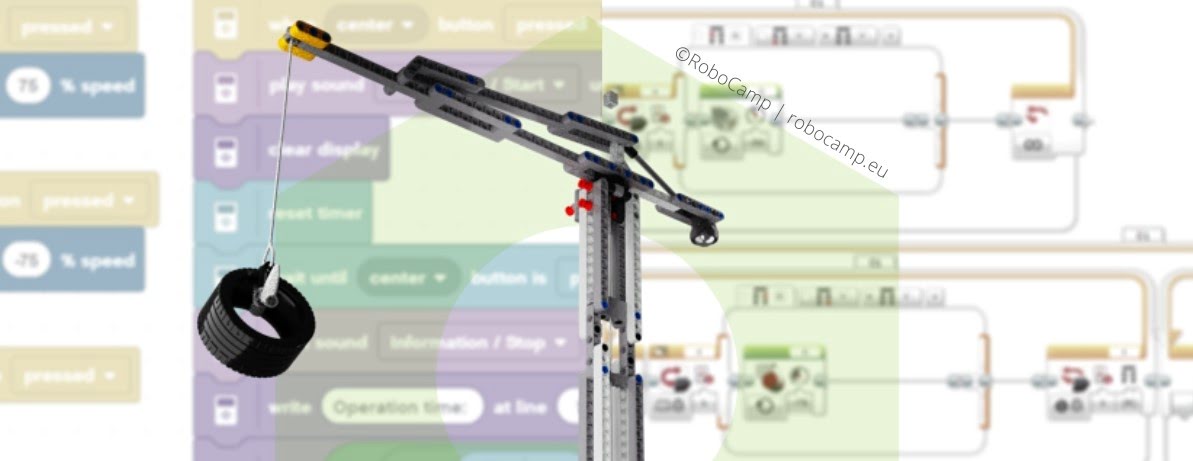
Jump straight to the function which interests yous the well-nigh, or savor the whole article from A to Z.
- Requirements
- EV3 Classroom Requirements
- EV3 Lab Requirements
- User Interface
- Programming and Code Blocks
- One program made in two apps
- Functionalities found only in EV3 Lab
- Conclusions, or which app is better
Requirements¶
Offset, let's meet if your computer can run the new EV3 Classroom programming software. New software often ways newer requirements, and then incompatibility with Windows 7 and eight.one should non come as a surprise.
Except it comes from LEGO®, a company that proudly claims to provide support for products launched years ago, so this is slightly unexpected.
On a brighter note, what's really great about EV3 Classroom is that all of its coding features are available on all devices, and then it doesn't matter if you lot have a PC, laptop, iPad, Android, or Chromebook - all of them will work! This is an important comeback from the previous app (EV3 Lab), which could exist used on tablets in theory, but in a version stripped down to such blank minimum that it had no real application. If you would like to endeavour information technology out, or encounter what you are missing, cheque out this article, where we talk in depth about the MINDSTORMS® EV3 kit. Fortunately, with EV3 Classroom, you no longer need to worry well-nigh tablets.
Both apps are available in sixteen language versions, making robot programming more than accessible to kids and adults worldwide. Considering that around 5.vii billions of people are using languages other than English to communicate, that's an of import characteristic.
Speaking of communication, the way you connect the EV3 Brick to your device has changed. In EV3 Lab, you lot could (and still can) rely on the USB cable, Bluetooth two.0 or WiFi to establish a connexion betwixt your device and the EV3 Brick. In the new EV3 Classroom app, however, you can just use USB and Bluetooth 4.0 or newer. WiFi connection was withdrawn, which has consequences for coding possibilities.
Without whatsoever further ado, we present the list of official requirements for EV3 Classroom and EV3 Lab.
EV3 Classroom Requirements¶
PC and laptop:
- 1.5 GHz Intel® Core Duo processor - equivalent or better
- 4 GB RAM
- 2 GB bachelor difficult disc space
- Bluetooth iv.0 or higher
- Operating system:
- Windows x ver. 1803 or newer
- macOS Mojave 10.14 or newer
Tablets iOS (click to open)
- Pad Air 2 or iPad Mini 4 or newer
- iOS 11 or newer
Tablets Android (click to open up)
- Screen resolution eight" minimum
- three GB RAM
- iii GB available hard disc space
- Bluetooth 4.0 or college
- Android 7.0 or newer
Chromebooks (click to open)
- 1.forty GHz Intel® Celeron® 2955U Dual-core processor – equivalent or better
- 4 GB RAM
- three GB available hard disc space
- Bluetooth 4.0 or college
- Android 7.0 or newer
- Required admission to Google Play Shop (Android App on Chromebook)
- Internet connection
EV3 Lab Requirements¶
PC and laptop:
- 1.five GHz processor or faster
- 2 GB RAM minimum
- ii GB available hard disc space
- USB port or Bluetooth 2.0 or higher
- Screen resolution 1024 ten 600 minimum
- Operating organisation:
- Windows vii, Windows viii and Windows 10 (except Win RT)
- Mac OS 10 10.6 (Snowfall Leopard); incompatible with Mac OS 10.xv (Catalina) and higher
Tablets (click to open up)
- EV3 Lab app is available for Chromebooks, iPads, Android and Fire tablets, only in a version that significantly limits programming possibilities (click to learn more than about it), so we don't recommend information technology for programming robots. However, if you'd still like to endeavor information technology out, head here to see the official requirements.
You but need 1 glance to understand that coding with EV3 Classroom requires new, more than avant-garde hardware.
Many schools are lucky enough to have this kind of equipment. Because of the pandemic and mandatory online classes, some might have even received extra funding to overhaul their computer supplies. And since EV3 Classroom gives equal opportunities to all devices, some students can utilise laptops, while their classmates work with tablets. Such lessons would certainly exist challenging to manage for the teacher, but doable. This means that despite higher hardware requirements, EV3 Classroom is nevertheless potentially accessible to numerous students.
Unfortunately, not everyone has access to the latest computers. Does this hateful you should give upwardly programming robots? Certainly not! You and your students can yet learn how to lawmaking in visual programming software, simply not with the latest app. This might really be a approval in disguise, considering many bugs and glitches are either already stock-still, or solutions tin be easily found online (bugs are non characteristic of the older software, both apps accept them).
If you have MINDSTORMS® EV3 sets and older hardware, you can utilize EV3 Lab or Scratch. The first one has more than possibilities, but the interface and coding arroyo takes getting used to. Read on if you want to learn more.
User Interface¶
First app impressions are made past the welcome screen. In the example of EV3 Lab, first impressions could be condensed into unexpected defoliation.
Eager to test your new set, you open the programming app and… don't really know where to get. The interface seems to propose that earlier y'all achieve the editor, you must go through compulsory MINDSTORMS® orientation. If you are perceptive, you will detect "New Project" just below, which fills you with hope again. But you need to make one more important decision: practise you want to start a new program, or a new experiment? And what is the difference?
More seasoned users know that the fastest mode to outset programming in EV3 Lab is to select the shortcut "Add Projection" in the top left corner, marked with a small-scale plus. It is there, merely information technology'southward not obvious. This is just one example of many confusing interface solutions in EV3 Lab, which means that overall, EV3 Lab requires more effort from the user. Not necessarily when it comes to programming, but if yous want to efficiently navigate the app and make use of its additional features, you must read EV3 Aid and prepare before.
EV3 Classroom, on the other hand, welcomes new users with a clear choice. Yous can either get a brusk introduction to EV3 in three steps, or skip this and go straight to creating a new programming projection. Easy and understandable. Even more then, if you are already familiar with LEGO® Educational activity Fasten app - the welcome screen is almost identical. Easy first in EV3 Classroom is certainly a welcome comeback from the older software.
Adjacent stop - introductory tutorials. Tutorials by LEGO® are always proficient and worth going through, merely EV3 Classroom gets bonus points for a carve up Instructor Preparation tutorial. Although the contents are no dissimilar than the Prepare section of the EV3 Lab, calling out teachers direct to familiarize themselves with bones information is vital. When working with MINDSTORMS® in schoolhouse, teacher prep plays a huge function in the learning process of their students. For example, every EV3 Brick should exist given a unique name before creating a plan, which does not become readily apparent upon purchase. A well-visible recommendation from the producer is a pace in the right direction.
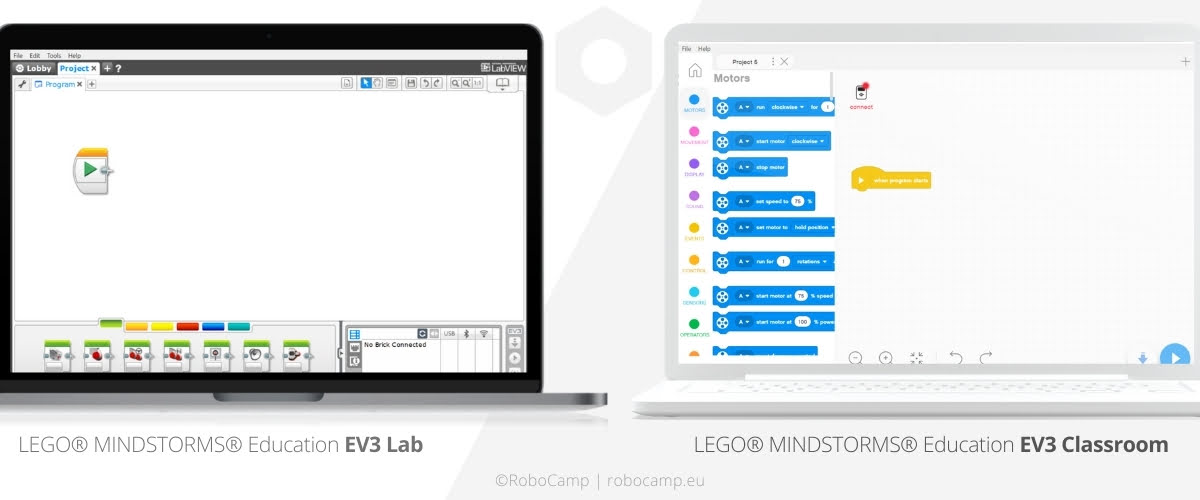
The heart of each app is the Programming Sail (or the editor), where yous select and connect programming blocks into stacks (i.eastward. scripts) to brand full-fledged programs for robots.
This part of the EV3 Classroom volition exist very familiar to anyone who has always programmed with Scratch or SPIKE. Editor on the correct, blocks palette on the left, block categories similar to those in Scratch… Stage and sprites were the merely affair cutting out. Before you commencement missing them, recollect y'all've got something amend - robots!
This I-can't-believe-information technology'southward-not-Scratch approach has two important advantages. Offset, in that location'due south a very good run a risk that students interested in advanced robotics with MINDSTORMS® will find this programming method more intuitive, because they probably already have some experience with Scratch (or SPIKE). 2nd, since all blocks are pocket-size and color-coded, assembling complex programs and revising them afterwards is really convenient.
Still, there's still room for comeback. As you browse the palette, you will notice that there'southward a lot of blocks, which means a lot of possibilities, right? Unfortunately, many blocks in EV3 Classroom are superfluous, perhaps included to facilitate building programs, or provide users with choices on how to arts and crafts a solution. In reality, the overabundance of unnecessary blocks creates a mess. To go far worse, you lot cannot extend the palette menu to see the blocks in their entirety. Yous have to hover your mouse over each long block to read the stop. Not a dealbreaker, just it rapidly gets tedious, especially if you're new to EV3 Classroom.
The editor of EV3 Lab is fundamentally different. Mind you, this is non necessarily bad. It was based on LabVIEW, a software used past real science laboratories, NASA and CERN. Programming blocks are presented with icons (proper name pops upon option), each has multiple modes and parameters, and all blocks are nicely sorted into easy-to-browse categories. Yous connect blocks into horizontal stacks. Ane might argue that if you lot accept zippo experience with programming, creating a simple plan with a motor, or a sensor, might actually exist easier with EV3 Lab.
Basic programs are easy to create in EV3 Lab. Circuitous ones are super hard – that'due south the main problem. Literally every cake has a myriad of modes and parameters, all of which can be used in your plan. To illustrate this, permit'due south consider the inconspicuous Await block - it has 68 modes to cull from! Moreover, as you lot aggrandize your program, it will abound longer AND wider, which makes information technology hard to keep abreast of your new creation. As a upshot, information technology'southward easy for users to become overwhelmed and disinterested.
Despite its flaws in interface blueprint, EV3 Lab has undeniably more programming possibilities. Jump here to find out exactly which functionalities were erased in the newer app.
Programming and Code Blocks¶
Both EV3 Classroom and EV3 Lab are visual-based programming languages, where you don't need to worry about syntax. In the first one, shapes of different blocks (chapeau, stack, C, reporter, boolean, cap) suggest where you lot tin apply them. The second coding app skips the syntax event by equipping every block with a ton of customizable parameters.
One of the most of import joys of programming robots is making them motility, so let's take a look at blocks responsible for motor command.
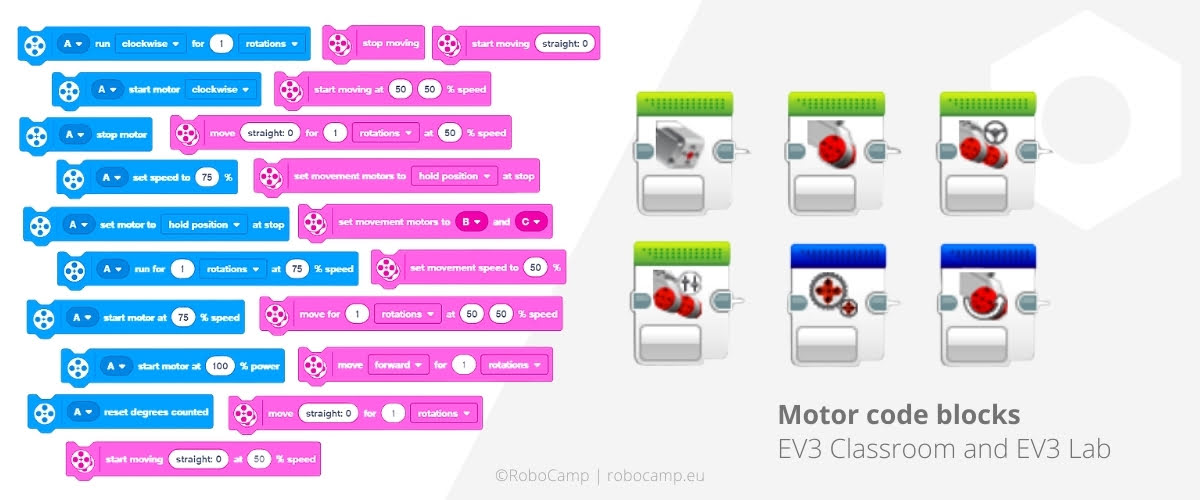
EV3 Lab is keeping it simple. Two interchangeable blocks for controlling private motors (Medium and Large), 2 more for controlling a couple of motors at the same time, plus ii blocks in the Advanced category - Unregulated Motor and Invert Motor. Functioning of individual motor blocks can exist adjusted in terms of power, duration, end manner, or steering. In improver, you lot can stop the motor from regulating the power automatically, or easily capsize management.
EV3 Classroom, on the other hand, has 20 blocks for motor control sorted into 2 split up categories: Move and Motors. What's the deviation?
Pro Tip: Speaking of EV3 Classroom classification, pay attention not to confuse "speed" with "power". Hither, "speed" is automatically regulated and delivers a stable rate of movement. When using "power", you only control the energy level to be used by the motor; the resulting drive does not compensate for whatsoever resistance, or the battery charge level (in EV3 Lab known equally Unregulated Motor). Use with circumspection!
Contrary to its name, blocks from the Motors category allow you to control merely one motor, while the Move category contains blocks responsible for controlling 2 motors simultaneously (i.e. more often than not used for robot movement). Out of these 20 blocks, some are only not needed. Functionalities of some overlap others, making information technology more than difficult to discover the block you really want. Granted, you can now program exactly the same task in v dissimilar ways, but what'due south the signal?
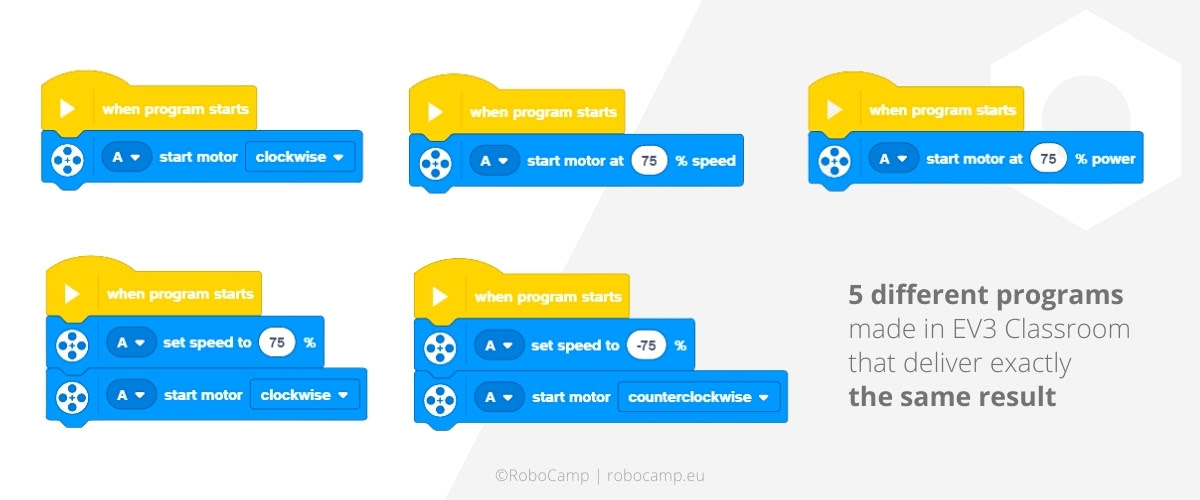
Next upwardly are the brandish blocks, responsible for programming the screen of your EV3 Brick. The possibilities of both apps are very similar, although if you want to brand your ain paradigm, you will have to apply the EV3 Lab. Proficient news is that all the other functionalities (displaying text, graphics from the library, or decision-making the LED light) are in EV3 Classroom, too.
Blocks treatment the flow of your program are amidst the near important in the entire palette. Again, EV3 Lab opts for credible simplicity: only 5 blocks in total (Offset, Wait, Loop, Switch, Loop Interrupt). Unfortunately, when you use them for multithreading, conditional statements, or annihilation more than basic, this system makes everything needlessly more complicated. Y'all easily cease up with a programme that is hard to interpret, modify, or improve.
In EV3 Classroom, the flow blocks (the Events and the Command categories) are easier to utilize and understand, partially because conditions, loops and wait commands are standalone elements. This style, they resemble the classic commands used by the majority of modern text-based programming languages. EV3 Classroom has however another reward - circulate and when I receive blocks, with which you can empower communication betwixt private scripts.
Events is my favorite category in EV3 Classroom. There was nothing similar it in EV3 Lab and I like using events in code. They make everything more than legible.
– Adrianna at RoboCamp
Sensors are the eyes and ears of every robot. In the original MINDSTORMS EV3 set from LEGO® Instruction y'all will find 4 sensors: the colour sensor, the gyro sensor, the touch sensor and the ultrasonic sensor (i.eastward. altitude sensor). All of them can be programmed in EV3 Lab and in EV3 Classroom with the same possibilities, which is good. Sensors from the Home edition, i.e. the infrared sensor and beacon, are also covered. Don't worry if you cannot initially detect them, they are just hidden. Click the "All Codeblocks" option to reveal blocks for the sensors included with MINDSTORMS® EV3 Dwelling house version set (31313).
At the moment you cannot programme any other sensors in EV3 Classroom, unfortunately. If yous want to footstep up your game with unincluded, unofficial, or retired sensors, yous will have to do it with EV3 Lab. More about it here.
Sensor blocks in EV3 Classroom are plenty, although not all are necessary. Just like other cake categories, the Sensors ane includes 2-in-1 and iii-in-1 premade blocks, which you could easily make yourself. Thus, scrolling through this choice takes longer than needed, peculiarly since you must hover the mouse over every longer block to read it (an expandable palette could easily gear up this). The adept news is they are sorted according to the sensor type.
Adjacent, we attain the math blocks. The Operators category in EV3 Classroom makes a really expert offset impression. It is clear, understandable, non-threatening and sufficient. What'due south more than, programming possibilities are very close to those available in EV3 Lab, yet much easier to implement. Still, there are some differences betwixt the 2 apps. EV3 Classroom introduces two new blocks: length of () and () mod (); while getting rid of several old ones, notably exponent, XOR, and truncate. Recreating most of them from blocks available is achievable, but not as convenient (or neat).
Variables and lists are in both apps, as well. A useful functionality, that's certain, simply you will find that in EV3 Classroom, variables are sometimes indispensable. I of the bugs of the electric current EV3 Classroom version (1.ii.2) makes it impossible to correctly send values from several reporter-type blocks to stack and boolean-type, and so you have to rely on variables every fourth dimension.
Also, pay attention to the information you enter into your EV3 Classroom variable or list. In that location is no automatic distinction between text and numbers, so whatever you enter, goes. All the same, using variables and lists is easier now for the user compared to EV3 Lab.
Last but not to the lowest degree, the elusive My Blocks. Both apps give you lot the opportunity to create custom blocks and use them later. This might come in handy, for example if yous want to employ repetitive functions, or introduce some avant-garde mathematical operations in EV3 Classroom.
Pro Tip: When creating new commands with motors, you can modify the port parameter by using the number assigned to information technology (due east.g. port A = 1, port B = ii etc.). Some numbers are available in the official user help.
If y'all have programmed in EV3 Lab earlier, yous may have already noticed that in that location's no Advanced blocks category in EV3 Classroom. Long story short, only 2 were transferred to EV3 Classroom: Unregulated Motor as start motor at 100% power and Stop Program every bit stop all stacks and exit program. Remaining 8 blocks, like Data Logging, or Invert Motor, are just unavailable in the new app.
One program made in 2 apps¶
Although both apps have similar programming potential, they are fundamentally dissimilar, which means that not all programs will be easily "translated" from EV3 Lab into EV3 Classroom. Unsurprisingly, they volition change in layout, often times in size. Programs recreated in EV3 Classroom will accept less space, despite beingness composed of more blocks. Sometimes yous may lack the right codeblock, sometimes new options may provide you with more than effective, or more interesting solutions. And let'due south not forget about pesky bugs that yous will have to featherbed.
Generalizations aside, let's examine how the program for the Forklift robot changes depending on the programming app. Watch the videos below for full programming instructions with the robot testing stage.
Building instructions for the Forklift robot are included in the CityCamp lesson series for MINDSTORMS EV3.
Which software would you choose for a lesson with the Forklift robot?
Both programs explained higher up make the robot perform the aforementioned task autonomously. All the same they appear and then dissimilar! The colors, graphics, fifty-fifty the direction in which y'all create the stack varies.
In EV3 Lab, parameters and options for programming statements are often already included in the block. Meanwhile, the blocks of EV3 Classroom are exactly every bit they seem on the surface, so creating an advanced statement is completely upward to you. This is why in the Forklift program, the condition made in EV3 Lab with simply one Wait block takes two divide blocks in EV3 Classroom - await until altitude is less than three cm and finish moving.
Note that in EV3 Classroom, there is no distinction between Large and Medium motors. In truth, this distinction was just cosmetic in EV3 Lab, so getting rid of it tin can exist seen equally an improvement. On the other hand, describing individual motors merely with the port they're continued to volition exist more than confusing to younger kids.
Similarities between the 2 programs are credible upon a closer look. Code blocks await differently, only the commands they correspond are comparable. Not only can you command either one or two motors simultaneously, most of options for programming motors are included in both apps. Interestingly, inverting the direction of motor rotation by adding the minus sign in front of the power works in each app, too! This tells us that although EV3 Classroom looks similar Scratch, its backbone was taken straight from EV3 Lab.
Moreover, a quick comparing of the two programs gives an insight into the personality of the target user for each programming app.
EV3 Classroom prefers users that are more than contained and remember to include the basics, like separately specifying the port your motor is continued to. On the other mitt, EV3 Lab requires from the user more than attention to detail ("are you certain you checked this parameter?") and patience for browsing all bachelor options.
Do you run across yourself every bit either one?
Functionalities found but in EV3 Lab¶
Despite its flawed interface, EV3 Lab is capable of creating highly advanced programs and has sophisticated functionalities to back up information technology. No wonder some of them were cut out, in order to simplify the programming learning process for kids.
Permit's see what we're missing in EV3 Classroom.
Say adieu to projects involving several EV3 Bricks at in one case (i.due east. Daisy Chaining). The option to connect EV3 Bricks via WiFi was completely removed, along with all communication possibilities that immune you to manage more than one Brick in your programme.
Recording new sounds (Audio Editor) and designing unique images (Image Editor, Shapes cake) to display on the screen of your Brick is no longer an option in EV3 Classroom. They may not seem of import from a teacher's perspective, but these tools immune artistically inclined students to personalize their project and have some extra fun.
Speaking of projects, keep them brusk. Many advanced blocks and tools for conducting long-term projects (due east.chiliad. Data File Log Manager, or Data Logging and Keep Awake blocks) are not included in the newer software. Non a reason to worry for most schools, but this conclusion may disrupt ambitious plans of afterward-schoolhouse robotics clubs.
Some mathematical operations were cutting out, like XOR (exclusive or), exponent, advanced (for trigonometry), truncate and range. If you are artistic and like math, chances are you will come with culling solutions, albeit not as pretty.
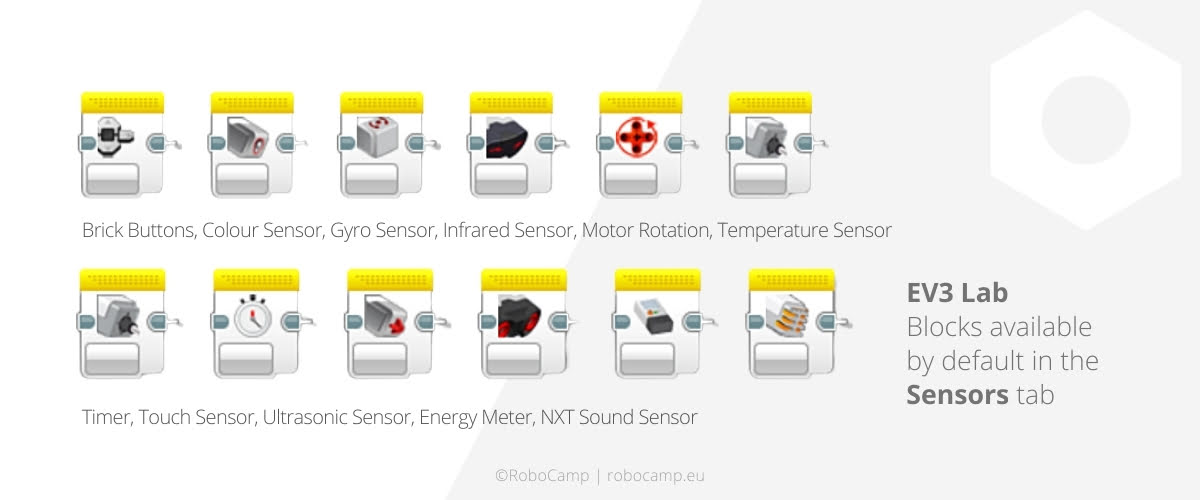
While EV3 Classroom is a rule-following formalist when it comes to sensors outside of the official kit, EV3 Lab is a existent rebel. In the older programming app, you tin utilize sensors from EV3, NXT, or even electronics produced by other companies! This liberty of choice is a powerful tool, which can transform your robot into almost whatsoever device you could imagine and assemble. The Block Import tool made the whole process even easier. Too bad the era of anarchy in the EV3 is backside us.
Fortunately, EV3 Lab is still available. To use these astonishing tools, y'all just need to download EV3 Lab for costless and install it on your computer.
Take fun!

Conclusions, or which app is amend¶
EV3 Lab and EV3 Classroom are fundamentally different programming languages, clearly designed with disparate objectives in mind.
The idea for the older app was inspired by LabVIEW. In consequence, EV3 Lab presents programming in the context of working with machines, like automatons, or equipment used in research labs. Focus on tangible devices is further encouraged by a wider array of electronics you can purchase separately and programme, or boosted options, such equally connecting and utilizing several EV3 Bricks in your project.
The new EV3 Classroom, on the other manus, is a close cousin of Scratch, originally created to ready kids for programming in text-based programming languages. In EV3 Classroom, you stack individual commands together to create a logical stream of events and actions, which incidentally teaches users the basic concept of syntax and the differences betwixt several types of programming commands.
Knowing the origins of the correct coding software already tells you a lot, only to choose the right one for you and your students, yous must also stop and think about what y'all want to achieve through programming EV3 robots. Even if you are not sure whether your students plan to work in a research lab, or develop an app in the futurity, you tin certainly predict what yous want to accomplish during your lessons together.
In curt, if y'all desire to simply innovate kids to the basics of programming with the aid of robots, go for EV3 Classroom. It'southward easier to grasp, to piece of work with and equips your students with cadre skills that they can develop in numerous directions. However, if you want to realize long-term projects exceeding 1 lesson unit of measurement, teach scientific discipline with robots, or conduct experiments with additional sensors, yous may be improve off with EV3 Lab.
Seems straightforward, but earlier yous make a concluding decision, give some thought to the weaknesses of each software. For instance, EV3 Lab makes complex programs look bulky and hard to read. Actually unfortunate, especially since this app has tools that are useful merely when practical in extensive programs. The interface is less intuitive and looks a bit outdated. And so again, it has no issues with connecting to the EV3 Brick, different EV3 Classroom. The new app is more than user friendly, but also overburdened with superfluous code blocks, while some of the actually useful blocks were removed.
Moreover, y'all volition accept to deal with and work around bugs in EV3 Classroom. Nosotros have already started working on some other article to help you with this issue, so don't worry - help is on the fashion! In the meantime, brand sure to follow our step-by-pace programming instructions to avert any issues.
As you can come across, there is a lot to ponder nigh.
Although frankly, in some cases, you may non take a option. If you accept older computers that just do not meet the requirements of EV3 Classroom, you will have to stick to EV3 Lab. Then again, if you are programming with tablets, the only option that makes sense is EV3 Classroom, considering the tablet version of the other app was then trimmed downwards that inappreciably whatever code blocks remain.
Ultimately, whether yous cull EV3 Classroom or EV3 Lab depends on your hardware and personal preferences.
We have worked with both apps at RoboCamp and honestly, there is no clear winner. None of them is perfect. Nevertheless, when I asked my colleagues off the record which programming app for MINDSTORMS® they prefer, nearly of them chose EV3 Classroom.
Source: https://www.robocamp.eu/en/blog/lego-mindstorms-ev3-classroom-app/
Posted by: chungandutimmose1944.blogspot.com


0 Response to "Can You Upload Ev3 Programs From The Brick Onto An Ipad"
Post a Comment